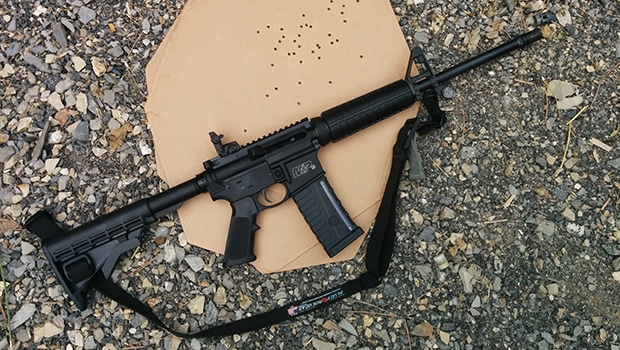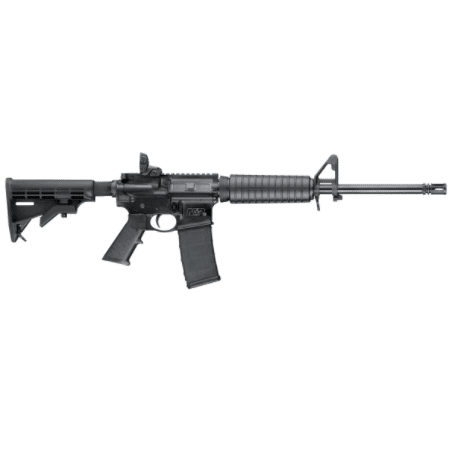At a Glance: Smith & Wesson M&P Sport
Smith & Wesson has made a name for themselves with their long-standing production of quality wheelguns, but since 2006, they’ve also been producing quality AR-15 style rifles. I recently picked up an affordably priced M&P15 Sport and took it out for a spin. After some prodding from Destinee, I decided to give it a full writeup.
Smith & Wesson M&P15 Features
Upper and Lower Receiver
Both the S&W M&P15 Sport’s upper and lower are made with 7075 T6 aluminum (the upper is marked with the splintered “A,” which means it has been forged by Anchor Harvey) and are finished with a black anodized hard coat. Smith&Wesson designed the Sport with neither forward assist nor dust cover.
One feature unique feature on the M&P15 Sport’s lower receiver is its rounded winter trigger guard, which is forged in one piece with the lower receiver. This has probably been made to save some costs, but it is, in my opinion, a nice feature that many users appreciate.
The upper receiver has M4 cuts, perfectly matching with the feed ramps on the barrel extension.
Barrel
Chambered in 5.56 NATO, is made of 4140 steel, is 16in length, and has a 1/9in twist rate. The business end is threaded, and it comes with an A2 style flash hider. It is not a standard government contour, it is thinner under the handguard, but it doesn’t have the recess for the M203 (I need to find another way to install mine) .
The barrel bore is not chrome-lined, even though the early models of the M&P15 Sport were equipped with a chrome-lined one. It was a very interesting barrel since, other than the chrome lining, it also has a 5R rifling with a 1/8in twist rate. Smith&Wesson has changed barrel type around 2013. Under the handguard, the barrel surface is not smooth, so it may be harder to keep it clean and rust-free.
Bolt Carrier Group
Chrome lined, as is the inside of the gas key. The exterior finish is well made, even though some machining signs can be seen on the inside of the rear end of the BC.
Controls
that is, trigger, safety, charging handle, mag release button and bolt release button, are all standard. The trigger is a single stage, and in the model I own is very heavy. I don’t have the trigger pull gauge, so I can’t give you the exact value, but believe me, it’s heavy!
Buttstock
A standard 6 position collapsible stock. The plastic handguard is thinner, and in my opinion more ergonomic, than the standard M4 handguard. It doesn’t have the aluminum heat shields inside. The handgrip is the standard A2. To meet some of the restrictive state or local regulations, the M&P15 Sport is also available with a fixed stock and 10rnd magazine, or with a fixed 10 rounds magazine that is removable only with the use a tool. This last system is called Bullet Button, since the magazine can be detached with the use of the tip of a bullet.
Iron Sights
Devices installed on the M&P15 Sport are a standard A2 front sight post/gas block, and a Magpul MBUS rear sight installed on the upper receiver Picatinny rail.
Magazine
that comes with the rifle, is a 30rnd Magpul PMAG M3 (the magazine in the featured image is a CAA MAG 17 that I used for the test).
Smith & Wesson M&P Range Performance
To test the M&P, I decided to take it in an outdoor environment, to verify its reliability in dirty conditions. So, I took my bug-out bag and headed for the mountains for a three-day trip.
My intention was to make a lot of walking through bushes and high grass, sleeping outside under a tarp, and stopping every now and then to engage some pre-positioned targets with the Smith & Wesson.
My expectations were against the poor M&P, first, because I’m generally skeptical about the AR-15 platform reliability, second, because of the lack of the dust cover, and third because I know that new semi-auto firearms often need some break-in before starting to function flawlessly. I’ve had to reconsider my thoughts.
During my trip I shot a total of 500 rounds, all 62grn military surplus, doing slow aimed shooting (covering the marksmanship fundamentals), and fast-paced shooting (performing dynamic drills); I had no malfunctions at all. Even carrying the rifle all day long for three days, it didn’t get very dirty. What I was more worried about, was walking through tall grass with the rifle at patrol ready. Since it doesn’t have the dust cover, I thought dirt and dust from the grass would have got inside the upper. However, at the end of the trip, I found very little dust and debris (the only strange thing I found was a small feather inside the trigger group, no idea where it came from). I didn’t make experiments like pouring gravel, sand or mud into the receiver, since that’s not what one usually do during the normal use of the rifle, even if rough. When I got home, I stripped the rifle for a thorough cleaning to prepare it for the second tests phase.
Accuracy
The second test I wanted to perform, was an accuracy test. I know that such a test is not so useful, considering the type of gun and considering the type of ammo, but I wanted to know what are the real capabilities of the rifle. I installed my Falcon Menace 4-14X44 ad headed to the range. The farthest range at which I was able to shoot was 50m, so I performed the accuracy test at that distance. I tried two types of ammunition:
- Surplus 5.56 NATO SS109 (62grn bullet) made by the Spanish Santa Barbara de Industria Militares in 1991. The same ammo I used for the outdoor test.
- Commercial Fiocchi 223 REM with 55grn FMJ bullet.
I shot 6 groups for each ammo, slow aimed shots but without waiting for the barrel to cool between each group. I then measured the group sizes and make the average. With the Surplus SS109, I obtained an average group size of 31mm. With the Fiocchi 223 I obtained an average group size of 24mm. Nothing impressive, but acceptabel for the type of rifle and the intended use. Shooting with iron sights or with a red dot, the rifle will always be more accurate than I could be.
Errors
After the accuracy test, I continued with the dynamic drills and that’s when I had the first, and so far the only malfunction with the rifle. After around 300 rounds after the cleaning, I had a Failure to Extract. One of the surplus ammo case remained stuck in the chamber, the rim partially ripped by the extractor. The BC had enough rearward force to be able to grab another round from the magazine and push it toward the chamber, giving me a sort of double feed, too. I had to remove the stuck case with a cleaning rod. I then fully stripped the rifle and controlled for excessive dirt on the bolt face or inside the extractor, or for an extractor malfunction.
The extractor was OK, and the bolt face was dirty, but not dirty enough to give problems in my opinion. I’ve read various forum that this is a common issue with the Santa Barbara Surplus. It seems that the brass is sometimes too soft and doesn’t support the amount of force applied by the extractor, especially on carbine length gas system like the one on the Sport. After cleaning the rifle, I went back to the range. I fired another couple magazines of the surplus ammo, plus another couple hundreds of the Fiocchi ammo without any other issues.
Final Thoughts – Is The S&W M&P 15 Sport A Good Gun?
The rifle performed very well during the tests, meeting the expectations. I believe the malfunction was actually related to the ammo since I’ve not found any sign of tearing on the rims of the other spent cases. For now, I’ll simply consider the Santa Barbara surplus ammo not 100% reliable in this rifle.
The M&P15 Sport I’ve tested, however, has some downsides:
- The trigger pull is heavy, too much for a sporting rifle, and it’s also not smooth at all, even after the almost 1000 rounds break-in and the countless dry pulls. It has been really hard to perform the accuracy test, sometimes I had to restart breathing two or three times during one single trigger pull. For this reason, I’ve already decided to switch to a Gaissele trigger.
- Handguard and butt-stock wobble a little. It is more annoying than anything, and common issues of most of the ARs with standard furniture I’ve seen around, however, it may become an issue having a rattling butt stock if you are stalking a pray (or if you are being stalked). I’ll change them soon.
- The Front Sight Base is slightly canted. It is unnoticeable to the necked eye, but I need 15 clicks to the right to zero the rear sight. That’s not a big issue, but it is annoying to not have the rear sight centered, and it probably take some fraction of seconds more to rapidly align the sights during timed drills.
- I don’t really like the MBUS rear sight which comes with the rifle. This is more a personal preference than anything. I know that they are sturdy and reliable, but to me they look too much like airsoft gear. I’ll switch to a Troy flip-up sight.
In my opinion, the absence of the dust cover is not a big issue for any shooting activity a civilian may want to do. The amount of dirt that can enter the receiver between each cleaning is not so much to worry about.
If you are looking for a service/patrol/survival rifle, however, that’s a different story, and the presence of the dust cover would be desirable. As for the forward assist, in my opinion, it would be useful for silently chamber around, even though I’ve tried to do it and it can be done pushing with the thumb on the bolt scallop. To clear a fail to the battery, I prefer to rack back the charging handle and chamber a new round since the “rack” is a common maneuver to the others malfunction drills.
Here again, if you are looking for a SHTF rifle, the forward assist may be desirable.
Overall, I felt confident to recommend this rifle to those with an eye on the budget but that are looking for a quality built and finished (entirely in the USA) and reliable rifle, to be used for recreational shooting, for dynamic shooting matches (with some upgrades), for hunting and for home defense. In my opinion, it is also a good base to work on if you want a custom gun but you don’t want to build it from zero.



